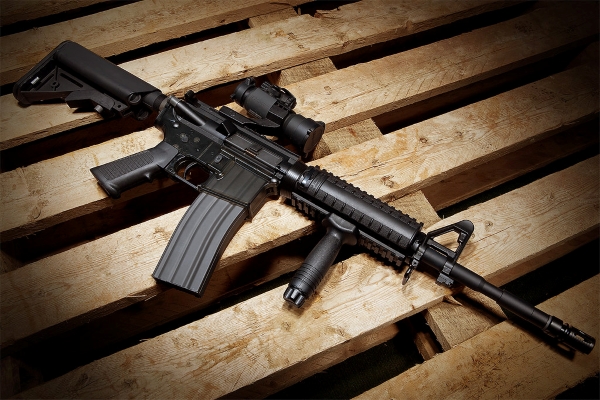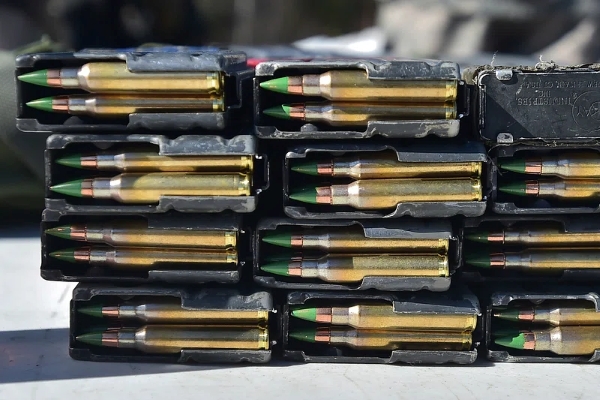A pistol brace is not a shoulder stock. It is a stock meant to be somehow attached to a shooter’s forearm to brace the gun. It was developed for shooters who have only one hand and arm to shoot with. The ATF pistol brace rule 2024 said the devices turned a gun into a short-barreled rifle, which requires a Class III tax stamp.
What is the ATF Pistol Brace Rule?
In 2023, the ATF pistol brace rule titled Factoring Criteria for Firearms with Attached Stabilizing Braces said a “firearm equipped with a ‘stabilizing brace’ device falls under the definition of ‘rifle’ if the weapon ‘has objective design features and characteristics that facilitate shoulder fire,’ as indicated on ATF Worksheet 4999.” In short, if you could put the brace on your shoulder and safely fire the gun, the brace was a rifle stock. If mounted to a rifle or pistol caliber gun with a barrel of less than 16 inches long, the gun became an SBR – short-barreled rifle and needed that tax stamp. If the barrel was longer than 16 inches, a brace made no difference.
ATF defined a brace as having a “surface area that allows the weapon to be fired from the shoulder.” The other criteria used to decide if the braced gun was a pistol or an SBR were:
- Weight or length is the same as that of a similar gun in a rifle configuration.
- The length of the pull is similar to that of the same gun in a rifle configuration.
- Sights, including a scope, red dot, or reflex, were mounted so that you had to hold the gun to your shoulder to shoot it.
- Presence of a buffer tube.
- The manufacturer’s marketing and advertising campaign could show the brace being used as a shoulder stock.
- Anything that shows how the gun would be used by “the general community.”
Opposition that started during the comment period on the proposed rule continued after the rule was implemented, resulting in a court decision declaring braces legal.
Among the arguments is that the ATF would not be consistent. The opening brief partly states that the rulings “were not always consistent, either in their methodologies or in their conclusions.” This is borne out by the record, as manufacturers submitted designs to the ATF asking if their product was among the ATF approved pistol braces. The answers were sometimes yes, sometimes no.
Another major argument that flew right in the face of the ATF rule was the agency’s own statement, that the brace manufacturer’s “stated intent will not necessarily be dispositive.” In other words, the ATF said the maker’s marketing did affect whether the device was a brace and did not matter to the decision on whether or not it was a brace.
The ATF’s pistol brace rule did not provide a concrete definition, something the Mock pistol brace update decision clearly points out. “Consequently, the Court finds that the Final Rule’s six-factor test is so impermissibly vague that it ‘provides no meaningful clarity about what constitutes an impermissible stabilizing brace,’ and, thus, that ‘it is nigh impossible for a regular citizen to determine what constitutes a braced pistol’ that ‘requires NFA registration.'”
What Happened to the ATF Pistol Brace Ban in 2024?
The ATF pistol brace ban was overturned in a lawsuit by the US District Court in Texas. Under the Mock v. Garland pistol brace update court ruling, pistol braces are legal for now across the nation.
“For the reasons set out above, the Court GRANTS Plaintiffs’ Motion for Summary Judgment on the grounds that the Final Rule violated the APA’s procedural requirements because it was arbitrary and capricious and was not a logical outgrowth of the Proposed Rule; DENIES Defendants’ Cross Motion for Summary Judgment; DENIES Plaintiffs’ request for a permanent injunction; and VACATES the Final Rule,” wrote US District Judge of the Northern District of Texas Reed O’Connor in the pistol brace update ruling.
This final order follows a nationwide injunction on the rule from 2023 in Britto v. ATF. Generally; courts only grant an injunction if the judge believes the side asking for the temporary stop has a good chance of winning in court.
In the Mock v. Garland pistol brace update decision, the federal court ruled the ATF pistol brace ban violated the rules listed in the Administrative Procedure Act (APA). In other words, the ATF did not follow the laws needed to create the pistol brace ban.
“Because Defendants fail to show that this is a rare case in which the Court should deviate from the default rule, the Court VACATES the Final Rule on the grounds that Defendants violated the APA procedural requirements in promulgating it,” Judge O’Connor wrote.
This ruling means the ATF cannot enforce the brace ban while any appeals work through the court system. However, as we explain below, the fight is far from over.
Are Pistol Braces Legal Now in 2024?
Are pistol braces legal? Yes, most commercially manufactured pistol braces are legal in 2024. Though this could change, and of course, we will keep you updated if and when the brace rule shows up again, either in court or in Congress.
The ATF pistol braces definition is “Such stabilizing braces are designed to conform to the arm and not as a buttstock,” says the ATF statement on the now-dead pistol brace ban.
What does that mean for the pistol brace rule? It depends on who you ask. If you ask 10 different ATF agents, you may get 10 or more different answers.
However, an ATF agent’s opinion, even if you get it in writing, is not a sufficient defense if you get hauled into court. The agent enforces the laws and rules. Interpretation of those laws and rules is done by the courts and the ATF’s upper administration.
Consider these ideas. Take the stock on your deer rifle and cut slots in it for straps. Is it a brace now? Could you mount straps to the stock with screws and call it a brace? Could you put a tennis ball stuffed with a bit of foam on the end of an AR15 buffer tube and call that a brace?
These are questions the Mock pistol brace update decision did not answer. These are also questions the ATF never formally answered with an official ruling.
What Pistol Braces Are ATF Approved?
If you are looking for a comprehensive list of ATF-approved pistol braces, it never existed. In fact, ATF said on Feb. 13, 2023, the agency does not have such a list.
“• No. ATF regulates firearms as defined by the Gun Control Act of 1968 and the National Firearms Act, and therefore, in general, ATF does not regulate accessories such as ‘stabilizing braces.’ ATF will provide examples of both commercially available firearms sold with “stabilizing braces” and common weapon platforms equipped with “stabilizing braces” that are considered SBRs at www.atf.gov .”
In reality, the “examples” might as well be approved braces, but the government does not work that way.
The ATF does have letters sent to brace manufacturers stating whether or not the brace was legal on a pistol. Many of these letters had a follow-up in which the ATF reversed its earlier decision. See the approval letters here.
Here is a short “approved braces” list with an ATF approval letter:
- SB Tactical SBA3, SBA4, SBM4, SBL, and FS1913 braces
- Shockwave Blade and Shockwave 2.0 braces
- Gear Head Works Tailhook MOD 1 and MOD 2 braces
- Strike Industries Stabilizer and SI Link braces
- KAK Shockwave Blade and KAK Shockwave 2M braces
Pistol Braces vs. Bump Stocks: What’s the Difference?
We’ve all seen the video of Congressman Cicilline being WRECKED by Congressman Thomas Massie over foolishly mistaking a pistol brace for a bump stock, but what is the actual difference between a pistol brace and a bump stock? These distinctions matter both practically and legally. Both do different things, which is why they are legally different.
A brace:
- Is a stabilizing device
- Does not change how the gun fires
- Has no moving parts while the gun is fired
- Does not affect the trigger pull
- Is not a full-length true stock
- Can fit on single-shot firearms, revolvers and pumps
- Is meant to be secured to the forearm and not mounted to the shoulder
A bump stock:
- Has parts that move when the gun is fired
- Can be a full-length true stock
- Allows the gun to fire more rapidly than just pulling the trigger over and over
- Is only used on semi-auto guns
- Relies on the gun’s recoil to cycle the trigger rapidly
- Is meant to be mounted to the shoulder
While you could put a bump stock on a revolver, pump or single shot, it would not function as it is designed to.
Both devices faced extensive legal challenges that saw the rules overturned. The brace ruling, explained above, was more confusing than the bump stock ruling. In plain English, President’s Trump’s executive order banning bump stocks said the bump stock changed the way a semi-auto gun is fired. It was too much like a full-auto to be allowed, the President said. Trump’s unconstitutional bump stock ban was overturned by the Supreme Court.
Join the Fight with NAGR
This is not over.
ATF can appeal the ruling. The US Supreme Court could agree to hear an appeal from the ATF. Congress could step in. Possibly, both could happen.
While the current High Court is leaning toward being gun-friendly, surprises are possible. The High Court could:
- opt not to hear an appeal
- support the decision
- modify the lower court’s decision
- overturn the decision
- send it back to the lower court for another hearing
If Congress takes action, exactly what can get pushed through is a big question. Democrats are pushing gun control in the run-up to the November 2024 elections. Braces are not mentioned nearly as much as semi-auto rifles and hi-cap magazines, but a pistol brace ban is definitely still part of the left’s agenda. Should the Democrats take the Presidency, House and Senate, only a Senate filibuster could stop a gun brace ban.If guns are important to you, then the National Association for Gun Rights is important to you. We are a no-compromise gun rights organization, and we will never sell you out in smoke-filled rooms with closed-door deals. You have the right to own guns. Period. While other gun rights groups may cave and back down, NAGR never will. Join today and keep your guns by helping us fight for you and them.
Disclaimer: This information is presented “as is” to benefit NAGR members and the public. Nothing here should be considered legal advice. Though we try to present accurate information, firearms laws, regulations, and court cases constantly change. Additionally, overlapping state and local policies may apply in your area. It is your responsibility to know and follow the law. NAGR makes no representation that any claim made here are current and accurate. Please speak with a qualified firearms attorney in your local jurisdiction for advice regarding firearm laws or your specific situation.
You can donate to the National Association for Gun Rights today!
About the Author
Taylor Rhodes is the Director of Communications at the National Association for Gun Rights. A seasoned political strategist and unapologetic defender of the Second Amendment, Taylor has led high-impact campaigns at both the state and national levels. He lives in Hoover, Alabama with his wife, Madison, and enjoys bourbon, golf, and collecting firearms—especially his 12.5” Geissele Super Duty.




